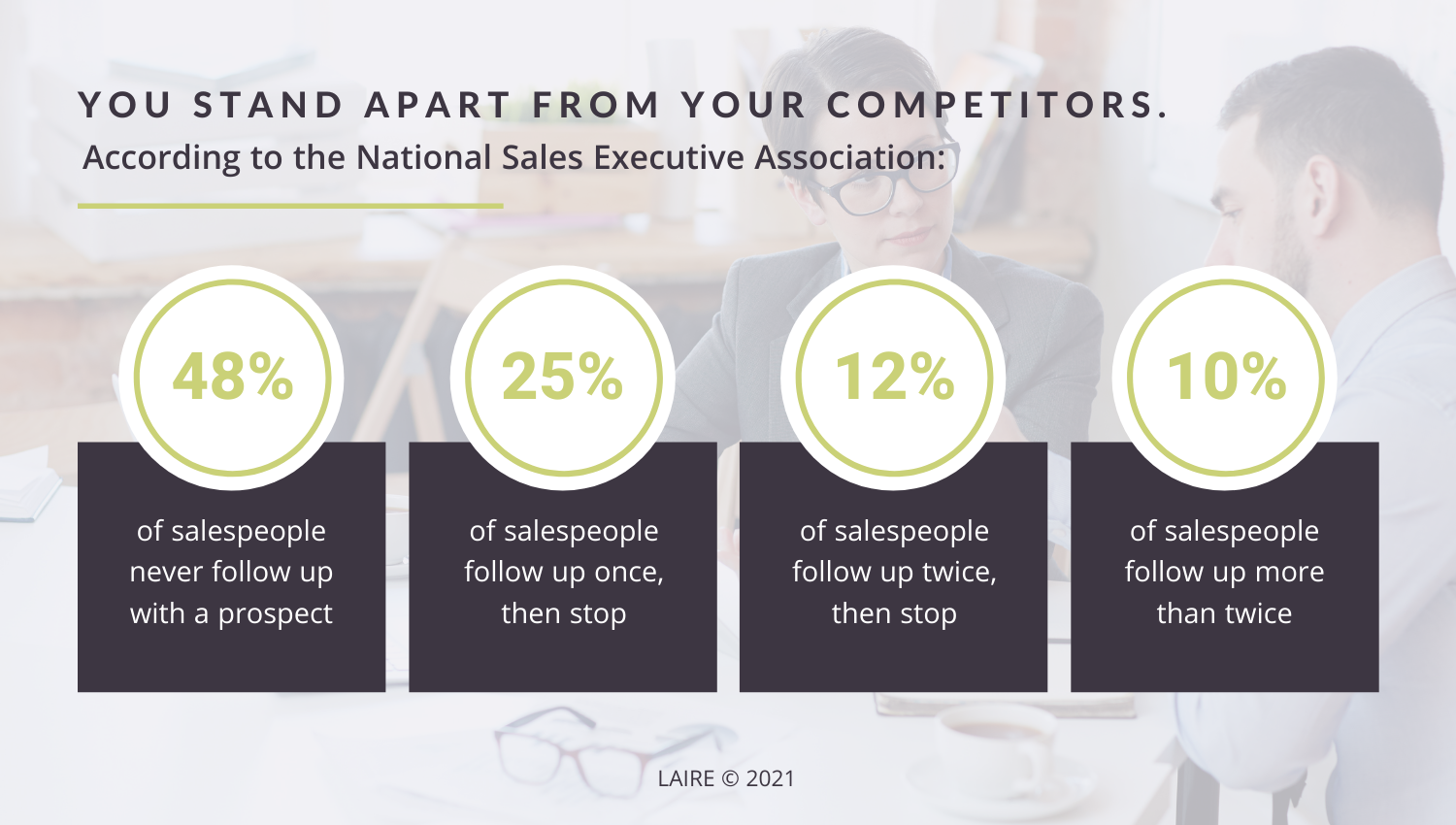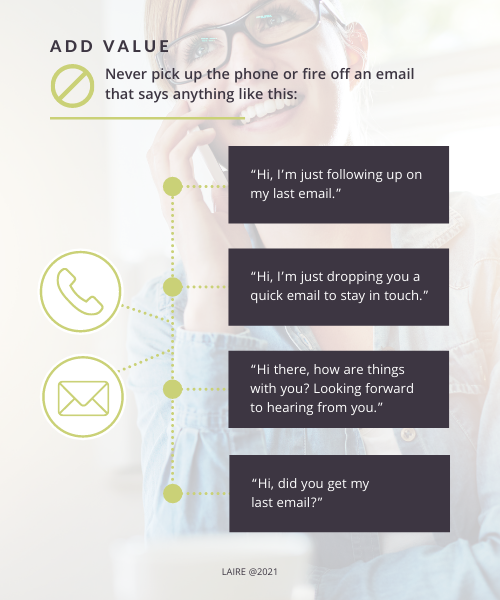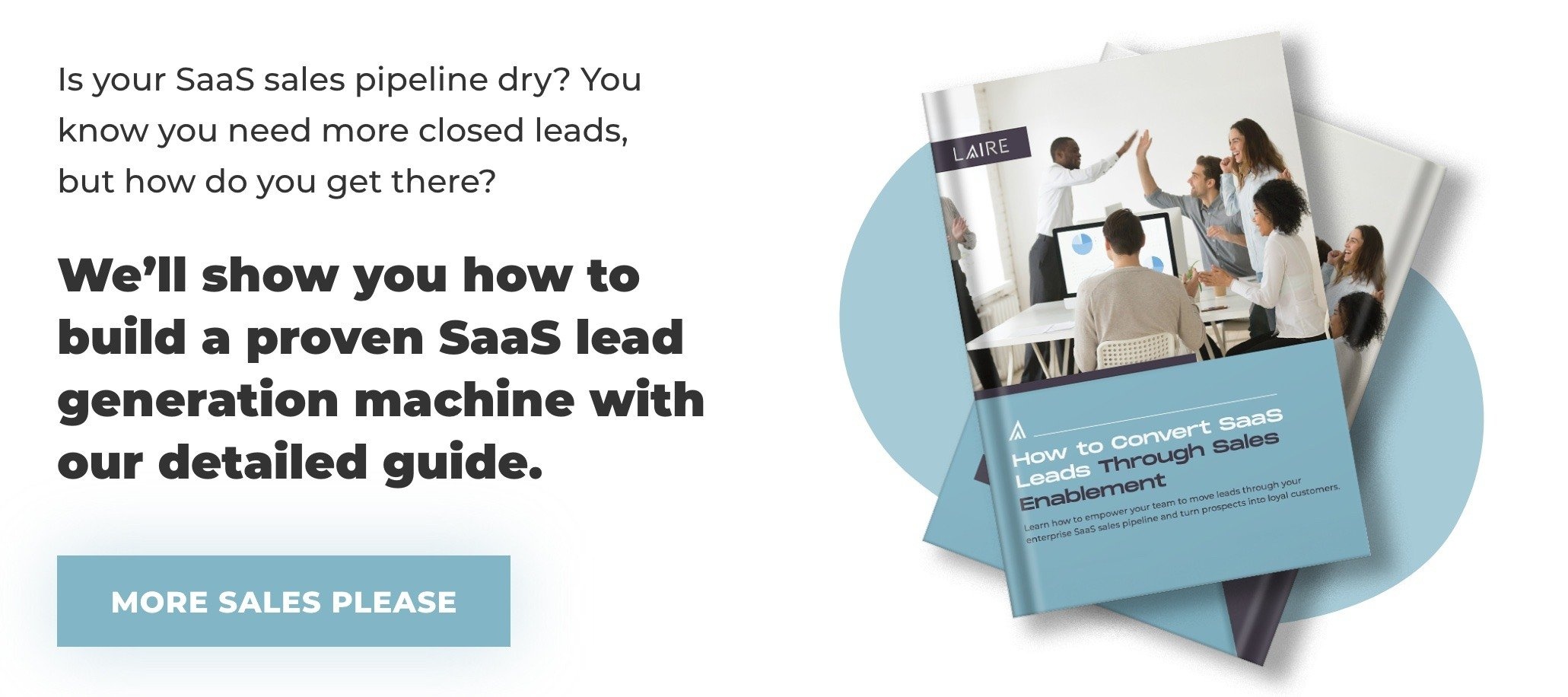When it comes to enterprise SaaS sales, the fortune is in the follow up. As you know, no enterprise buys a complex, expensive software solution after just one prospecting call or after just one sales meeting.
If you want to master enterprise SaaS selling, you must master your follow up. Here’s why—and how—to do it.
Why You Must Follow Up
1. You stand apart from your competitors.
According to the National Sales Executive Association:

- 48% of salespeople never follow up with a prospect
- 25% of salespeople follow up once, then stop
- 12% of salespeople follow up twice, then stop
- Only 10% of salespeople follow up more than twice
Do the math, and you see that 90% of salespeople do not follow up more than twice. Which means that, if you follow up more than twice, you immediately stand out from the majority of salespeople who are calling on your prospects.
When you follow up often, your prospects are more likely to remember your name, and the name of your company. You communicate a higher level of interest in helping your prospects achieve success. And you demonstrate that you believe in your solution.
2. You win more sales.
You may be wondering why the majority of salespeople don’t follow up with prospects more than twice. You may be tempted to think that following up clearly isn’t worth the effort, since the majority of sales reps don’t do it.
But the reason most salespeople follow up only once or twice and then give up has nothing to do with results and everything to do with human nature. Salespeople hate rejection. So salespeople hate following up.
The main reason to follow up with prospects multiple times is that it works. All things being equal, every follow up gets you closer to winning a deal. Again, according to the National Sales Executive Association:
- 2% of sales are made on the first contact
- 3% of sales are made on the second contact
- 5% of sales are made on the third contact
- 10% of sales are made on the fourth contact
- 80% of sales are made on the fifth to twelfth contact
Read that last bullet again. This is what we mean when we say, “The fortune is in the follow up.” A whopping 80% of sales require a salesperson to contact a prospect at least five times. That’s one initial contact and four follow-up contacts.
3. You keep your buyer engaged.
According to Forbes, 58% of pipelines stall because sales reps don’t add value. So, when we talk about follow up, we’re not talking just about following up with leads after the first prospecting call. We’re talking about following up with potential buyers who are somewhere in your pipeline. Almost six in ten of these buyers will bail on you and drop out of your pipeline if you fail to add value.
You fail to add value in one of two ways. Either you don’t follow up often enough (you are neither timely nor relevant). Or you follow up often enough, but what you have to say does not help your buyer (you are timely, but irrelevant).
The solution, of course, is to follow up often enough and to always deliver value, usually in the form of buyer-centric content that educates, differentiates, and helps them make a buying decision.
How You Must Follow Up
1. Go for the no.
Salespeople hate rejection. No surprise there. They dislike picking up the phone and dialing for dollars because they hate hearing “we’re not interested,” “we don’t have the budget,” and “now is not a good time.” In other words, sales reps hate hearing “no.”
But “no” is one of the sweetest words in the English language, especially in the world of enterprise SaaS sales. It ranks right up there with “Where do I sign?”
In sales, after all, there are essentially only three words you will hear during a prospecting call:
- Yes
- Maybe
- No
Which of these three responses is the best to hear? Naturally, it is the word “Yes.” But which word is the worst one to hear? It isn’t “No.” It’s “Maybe.”
“Maybe” prospects waste your time. They suck out your energy. They get your hopes up. They help you fail to reach quota. Nothing is worse than hearing a prospect say, “I may be interested. Call me back in two weeks.” You are better off hearing a firm “no” than a lame “maybe.”
To succeed at enterprise SaaS prospecting, go for the no. Do all you can to get prospects to commit to saying they have no budget, have no authority or have no need. And do everything you can to avoid adding “maybe” prospects to your calendar or CRM for follow-up calls that waste your life and fail to help you reach your sales targets.
2. Add value.
Effective follow-up educates, answers questions, addresses concerns, adds value and moves buyers along your pipeline towards a sales conversation, a product demo or a contract.

Never pick up the phone or fire off an email that says anything like this:
- “Hi, I’m just following up on my last email.”
- “Hi, I’m just dropping you a quick email to stay in touch.”
- “Hi there, how are things with you? Looking forward to hearing from you.”
- “Hi, did you get my last email?”
Your prospects are busy. They are juggling multiple priorities. If you want them to take your call or read your email, you must demonstrate relevance. A phone call that says, “Hey, I’m just phoning to stay in touch,” is all about you, the seller, not your buyer. Click.
But a call that says, “Hey Carol, Gartner just released their latest report on the challenges facing your industry. Want me to send you a free copy?” is likely to arouse the curiosity of the prospect, demonstrate that you care about their business beyond just landing a sale, and prove that you are a solutions-focused seller, not a simple sales rep for a software vendor.
3. Be systematic.
One of the primary reasons that salespeople fail to follow up with prospects (besides fear of rejection) is that they don’t have a system. They leave every prospecting call with good intentions of following up, but life always gets in the way, they move onto other priorities, and they neglect their leads.
If you want to succeed at follow up, you must put a follow-up system in place. This system typically consists of the following components:
1. CRM tracking system. You need a central system that stores all data about leads, prospects, opportunities, and customers, ideally a system that helps you visualize your pipeline and create reminders for following up.
2. Tags. To be successful, follow up must be both timely and relevant. You ensure both by labelling or tagging each prospect to show where they are in your pipeline and what the next touch should involve. These tags include such stages and reminders as:
- Left voicemail
- Sent introduction email
- Call back
- Schedule appointment
- Send quote
3. Notes. You demonstrate relevance to buyers by knowing as much about them as possible, including their industry, their market, their products and services, their challenges, goals, priorities and more. Keep this information in one central place, such as your CRM.
What you need is a proven, systematic way to stay in touch with leads over time. This means always knowing where each lead or prospect is in your pipeline at any given time, what the next touch is, and a way of reminding you to make that touch.
Conclusion
The key to success at follow up is to take your eyes off the sale and put them on your buyer. When you put your buyer at the center of your follow-up efforts, your results improve.
Effective follow builds trust—trust with you, trust with your product, and trust with your brand. Effective follow up also helps you address buyer concerns early in the sales process. You discover buyer fears, concerns and objections, and address them before they grow into deal-breakers.
By the way, somewhere on your journey of improving your follow-up system, you may discover that you need the help of a firm that specializes in crafting follow-up call scripts, email templates, and content assets for enterprise SaaS sales teams. We are that firm.
This blog is part of a six-part sales enablement series. Please find links to the remainder of the series below:
Chapter 1: Seven Unique Challenges Facing Enterprise SaaS Sales Teams
Chapter 2: Six Keys to Effective Sales Enablement for Enterprise SaaS Sales Teams
Chapter 3: Why (and How) Follow-Up is the Key to Enterprise SaaS Sales Success
Chapter 4: Eight Steps for Effective Follow-Up with Enterprise SaaS Leads
Chapter 5: Six Rules for Email Follow-Up with Enterprise SaaS Leads
Chapter 6: Five Ways to Create Sales Enablement Content that Moves Leads Along Your SaaS Pipeline


